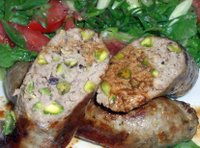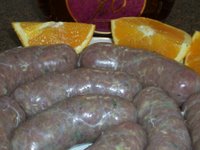More banger for your buck
Duck, orange, pistachio and cognac sausages
 Call me a control freak, but I usually like to know what’s in my food. Consequently, one foodstuff that relentlessly causes difficulties for me is the humble snag. Even the gourmet ones you buy at upmarket providores or food halls that boast some ‘it’ chef’s moniker are something of a mystery. When cooked, I usually find them too salty, too fatty, too dry, underseasoned, overseasoned etc etc. One can run about on a noble quest for the perfect snag, an action not recommended my many cardiologists, but my solution? Make your own. It’s really not that difficult once you’ve worked out a few basics. You won’t believe the inner satisfaction that comes from seeing glistening cases emerge from your mincer full of luscious goodness and knowing exactly what’s inside.
Call me a control freak, but I usually like to know what’s in my food. Consequently, one foodstuff that relentlessly causes difficulties for me is the humble snag. Even the gourmet ones you buy at upmarket providores or food halls that boast some ‘it’ chef’s moniker are something of a mystery. When cooked, I usually find them too salty, too fatty, too dry, underseasoned, overseasoned etc etc. One can run about on a noble quest for the perfect snag, an action not recommended my many cardiologists, but my solution? Make your own. It’s really not that difficult once you’ve worked out a few basics. You won’t believe the inner satisfaction that comes from seeing glistening cases emerge from your mincer full of luscious goodness and knowing exactly what’s inside. I think there are two cardinal rules of sausage making. Fat and mincing. Sausages have to have fat. Ideally at least 10% to make them moist and juicy. Many sausages have way more than that – up to 40% and beyond – and by all means if your arteries are made of teflon, go ahead and add as much as you wish. And sausage filling has to be minced. You can try to use a food processor but it will mulch rather than chop and you’ll end up with a pasty sausage. Mincers are pretty cheap – a decent metal one will cost about $80 including the sausage attachment, and the physical act of mincing is excellent for upper body strength and keeping those bingo wings on the lower side of your upper arm under control. After that, let your imagination run wild. You can buy sausage skins from your butcher. They come on a hollow rod, all squished up and salted. You need to soak the skins in water and a little vinegar for about 30 minutes before using them. You can either get natural casings (made from animal intestines – usually pigs) or collagen casings.
I think there are two cardinal rules of sausage making. Fat and mincing. Sausages have to have fat. Ideally at least 10% to make them moist and juicy. Many sausages have way more than that – up to 40% and beyond – and by all means if your arteries are made of teflon, go ahead and add as much as you wish. And sausage filling has to be minced. You can try to use a food processor but it will mulch rather than chop and you’ll end up with a pasty sausage. Mincers are pretty cheap – a decent metal one will cost about $80 including the sausage attachment, and the physical act of mincing is excellent for upper body strength and keeping those bingo wings on the lower side of your upper arm under control. After that, let your imagination run wild. You can buy sausage skins from your butcher. They come on a hollow rod, all squished up and salted. You need to soak the skins in water and a little vinegar for about 30 minutes before using them. You can either get natural casings (made from animal intestines – usually pigs) or collagen casings.This is a fave recipe because I do love duck so much. The ingredients for this one aren’t particularly cheap, but the result is spectacularly eyepopping upon the first taste, and just think how much smug satisfaction you will get when your guests ask “WHERE did you buy those sausages????”, and you casually respond with – “oh, I made them myself”. They’ll be gobsmacked and impressed you went oto so much troouble. In fact I have now started a line in special friend sausages. The GV is a lovely pork shoulder, garlic and fennel number, the Burgy is a honey, lamb, rosemary and pine nut creation. Recipes on those another time, and needless to say this is a project for a quiet afternoon rather than a quick mid week dinner. Although frozen home made sausages are excellent last minute meals.

1 duck and 4 duck breasts.
¼ cup cognac
1 tbsp fresh thyme leaves
4 eshalllots (French shallots) finely chopped
Grated rind of 1 orange
Salt and pepper
½ cup chopped pistachios
Sausage skins, soaked
 Take the skin off the duck and breasts and place into a non stick pan over a low-medium heat. Render the fat from the skin over about 30 minutes. Strain and reserve, allowing it to come to room temperature (whatever fat remains after sausage making you can use to cook luscious roast potatoes). Take all the meat off the duck and chop this and the breast meat into chunks – this should give you about 1 kg of duck meat (save the bones for stock). In a bowl mix the duck meat, seasoning, herbs, cognac and orange rind. Add some of the reserved duck fat to constitute at least 10% (more if you prefer) of the total weight of meat, in this case about 100 grams. Stir through the meat to distribute. Refrigerate for at least an hour. Place your assembled mincer in the freezer for the same length of time.
Take the skin off the duck and breasts and place into a non stick pan over a low-medium heat. Render the fat from the skin over about 30 minutes. Strain and reserve, allowing it to come to room temperature (whatever fat remains after sausage making you can use to cook luscious roast potatoes). Take all the meat off the duck and chop this and the breast meat into chunks – this should give you about 1 kg of duck meat (save the bones for stock). In a bowl mix the duck meat, seasoning, herbs, cognac and orange rind. Add some of the reserved duck fat to constitute at least 10% (more if you prefer) of the total weight of meat, in this case about 100 grams. Stir through the meat to distribute. Refrigerate for at least an hour. Place your assembled mincer in the freezer for the same length of time. It is infinitely easier to make sausages when everything is cold during the mincing part. The meat grinds better, the fat stays firmer, the blades don’t gum up. Set up your mincer and grind the cold meat mixture through it. After it’s minced, add the chopped pistachios. I like to add the nuts last so you get uneven chunks, rather than minced nuts, in the sausage. Now comes another important part. Before you make the mixture into sausages, fry a small amount to check for taste and seasoning. If you need to adjust it, test again.
It is infinitely easier to make sausages when everything is cold during the mincing part. The meat grinds better, the fat stays firmer, the blades don’t gum up. Set up your mincer and grind the cold meat mixture through it. After it’s minced, add the chopped pistachios. I like to add the nuts last so you get uneven chunks, rather than minced nuts, in the sausage. Now comes another important part. Before you make the mixture into sausages, fry a small amount to check for taste and seasoning. If you need to adjust it, test again.Now set up your mincer with the sausage attachment and watch with amazement as your fat scrumptious snags emerge from the other end. Twist them off into whatever size you want and store in the fridge for a few days (the flavour does develop a little as they sit) or freeze in batches.

Cook in a non-stick pan for best results, or bake in a 200°C oven, until cooked through. Remember – never pierce your sausage before cooking it.





5 Comments:
I'm so impressed!! I'm like you I like to know what is in my mince and sausages.
Great work!
Oh. YUM!
Thanks Pickles - the good work was all worth it in the eating!
Yum indeed Julia!
'Reb's snags', Helen? I'd have to get an electric grinder coz I'd look like a body builder if I had to grind that meat manually!
I can't believe you make your own sausages. I've already raved about this to someone else. Another one to add to the to-do list.
I would so buy these sausages...
Tell me, do you not buy ANY sausages at all?
Thanks Sue - I rarely buy them now, although if I'm pressed and there's none in the freezer :) I find if I make a batch they last a while so they are pretty handy. It's fun to have friends over to help you too and they can share in the bounty.
Post a Comment
<< Home